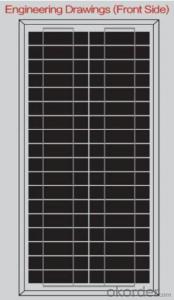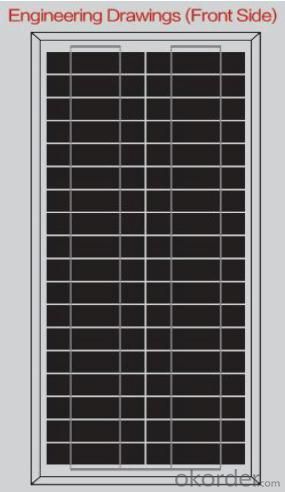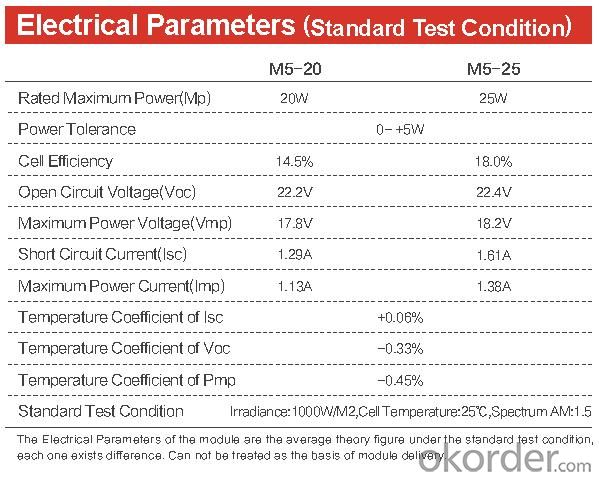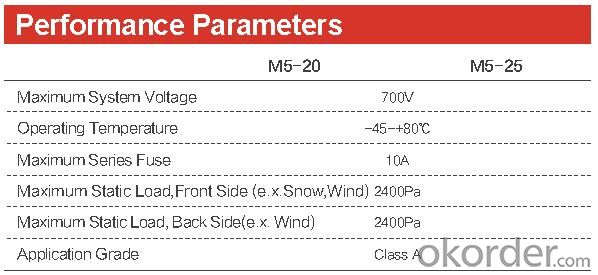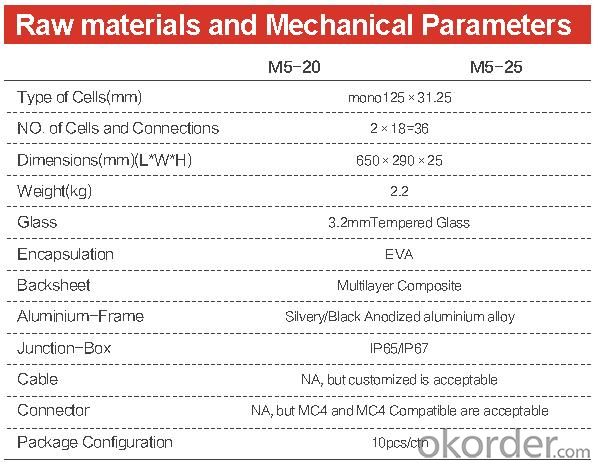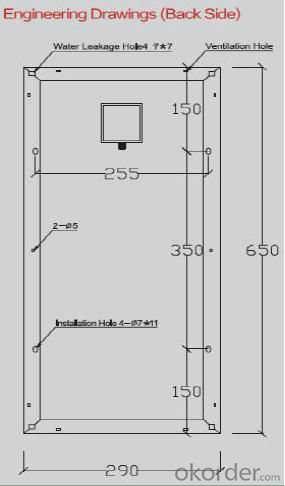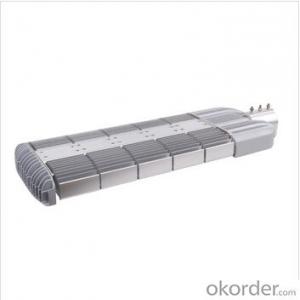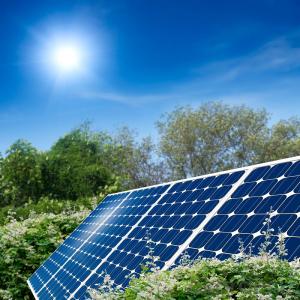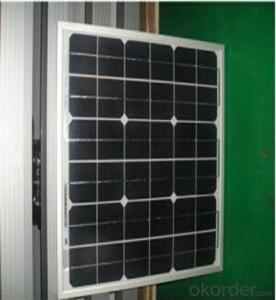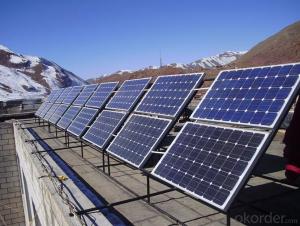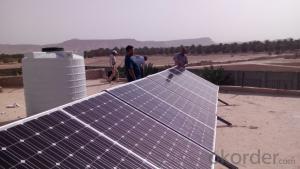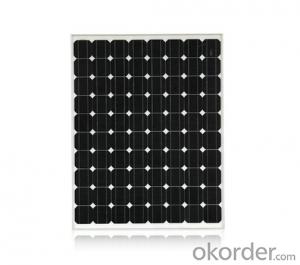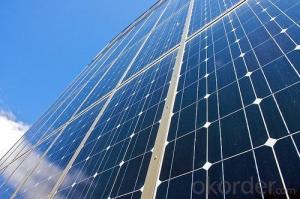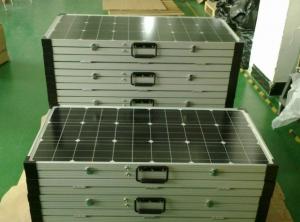Best Portable RV Solar Panels - 125mm Series CNBM Solar Monocrystalline (20W-25W)
- Loading Port:
- Shanghai
- Payment Terms:
- TT or LC
- Min Order Qty:
- 5000 watt
- Supply Capability:
- 85000 watt/month
OKorder Service Pledge
OKorder Financial Service
You Might Also Like
CNBM Solar Monocrystalline 125mm Series (20W—25W)
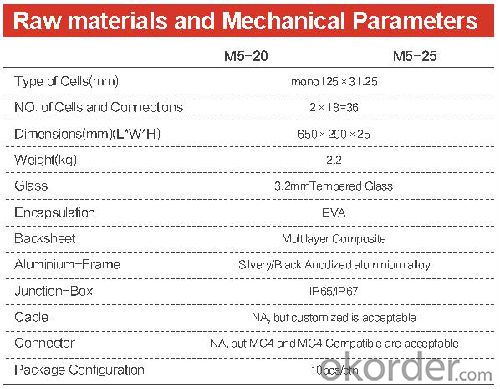
Mechanical Data
Dimension :650×290×25mm
Weight :2.2kg
NO. of Cells and Connections: 2×18=36
The dimension of the modules can be changed according to the demand of clients
Limits
Operating Temperature –45 °C to +80°C
Storage Temperature –45 °C to +80°C
Max System Voltage 700V
Guarantee
Products Guarantee 5 yrs free from defects in materials and
workmanship
Performance Guarantee No less than 90% within 10yrs and no less
than 80% within 25yrs
Certificates
IEC, ISO, CE
* The data does not refer to a single module and it is not part of the offer, It is only for comparison only to
different module types.
FAQ
We have organized several common questions for our clients,may help you sincerely:
①What price for each watt?
It depends on the quantity, delivery date and payment terms,
②What is your size for each module? Can you tell me the Parameter of your module?
We have different series of panels in different output, both c-Si and a-Si. Please take the specification sheet for your reference.
③Can you provide the peripheral products of the solar panels, such as the battery, controller, and inverter? If so, can you tell me how do they match each other?
Yes, we can, we have two companies for solar region, one is CNBM International, the other is CNBM engineering Co.
We can provide you not only the solar module but also the off grid solar system, we can also provide you service with on grid plant.
④What is your warranty system?
Our product performance guarantees for 25 years
• 12 years guarantee for workmanship
• Timeliness of delivery
• Quality Products certified (TÜV, UL, CE, ISO)
⑤How do you pack your products?
We have rich experience on how to pack the panels to make sure the safety on shipment when it arrives at the destination.
⑥ Can you do OEM for us?
Yes, we can.
⑦How long can we receive the product after purchase?
In the purchase of product within three working days, We will arrange the factory delivery as soon as possible. The pecific time of receiving is related to the state and position of customers.Commonly 7 to 10 working days can be served.
- Q: I'm thinking of having solar panels to generate electricity. The drawbacks are that I'm afraid if it needs repair, I won't be able to find anyone. Also I'm afraid that the roof is not very accessible. If it is a new house, should the roof have a roof hatch? What can make the system not work?
- Modern solar electric panels rarely fail. Because of this, if you would be installing them over a roof that only has a few years left on it, it would be better to redo the roof, first. In the unlikely event that a panel needs to be changed, this can be done in 30 minutes or so, because the panels are mounted on racks, with everything simply plugging together. I have never personally seen a solar installation go bad, but from what I hear, the inverter (a box that goes in next to your electric service panel) is usually what burns out after 5 years, assuming the install was done right in the first place. If you were to call roofers to repair your roof, they would somehow be able to get to your roof, by ladders, or a special truck. Solar installers use the same kind of equipment. They won't have a problem getting up there. A solar electric system is actually a very straightforward thing. No matter who installs it, if there is a problem, another installer should be able to diagnose and fix it.
- Q: I'm from Toledo, OH about 2 miles from the MI line. We are a foster family and have adopted 5 children. We just moved into a 5400+sq 2 story home. We have (3) 2.5-3 ton AC units to cool this huge house. We got the house cheap...$75k couldn't pass it up! Anyway...I was wondering how many solar panels it would take and of what wattage to power these Central Air Units and maybe the rest of the house. We have 3 people in our home......9 of which are children who leave the lights on and run hot water to beat the band. We have all brand new energy star appliances and front loader washer and dryer. Gas Range and Gas hot water tank. Was thinking of using metal window frames and buying solar cells and making my own panels. Just don't know how much to buy. We face south with no trees. Constant Sun. thanks for your help. An e-mail address to bounce questions off of would be helpful if you experienced. tx.
- Basically, the answer to your question is forget it. Your approx 8 tons of AC will require about 28 KW of electricity just to run them. Add the rest of the house requirements and your talking a load of 50KW or more. Even if your state has a subsidy program, (and most of them are out of money now), it's a $200,000. system. Making your own panels would be a mistake. Reliability and survival are the key measures for a panel system and homemade panels are just not going to be reliable enough to survive the cold winters. In the end, it is always cheaper to buy good, conservatively rated commercial panels, especially in view of the fact that prices have been tumbling lately. Often, the mounting, interface and conversion costs are greater than the cost of the panels themselves. You might save some bucks by fabricating a mounting framework yourself and installing it, but such a system would not qualify for most state programs and.... you had better be an expert architect or engineer to put together something that will work well. The basic problem after all of this is that your maximum demand will be at night and the panels put out nothing at night. Better to forget about a 00% solution. You can install a modest 0 - 20KW system for perhaps $50,000 costs after rebates and subsidies and perhaps ... it might cover about /4 of your energy needs and might just, pay the investment back in 0 to 5 years. Get first rate equipment and professional installation, if you want the system to perform reliably. Solar voltaics make a lot of sense for Arizona and perhaps Florida. For anyone north of the Mason Dixon line however, fossil fuels are cheap, reliable and work far better.
- Q: was looking at a few different sites, here is one of them
- I had a system installed recently, so I would suggest starting by getting a quote from a licensed contractor. Even if you are planning on doing the installation yourself, a contractor will have a lot of useful info. I got 3 quotes and they were all about the same cost. I was able to get a 2 year usage history from our utility so the contractors were able to suggest a system based on that. They were able to tell me about rebates and tax credits, were the best location would be and the estimated amount of production. They have a nifty gadget that can tell if there will be any shade cast on the roof at any time during the year. I decided to maximize my rebates and got a system that reduced my utility bill by about 50%, although my production has cut it much more than that, my highest electric bill was $35, and that was in Dec. with cloudy short days. I got a $0K rebate and a $2K tax credit. This year the fed. tax credit is 30% of the total installed price. My system cost $26K, I paid $6K out of pocket and I'm saving about $2K per year.
- Q: I'm looking at solar panels and I have NO IDEA what this stuff means.They come in catagories of Watts. What does that refer to? If a solar pannel is in the 200-watt catagory, what does that really mean? Will it produce 200 watts an hour, a day, a week, a month, a year?? How many watts of energy does the average house use up in one month? I really wish they would just tell me on the website!! :(0 points!!!!!!!! :D
- 200 Watt Solar Panel
- Q: Can solar panels be recycled?
- Yes, solar panels can be recycled.
- Q: Do solar panels require regular cleaning?
- Yes, solar panels do require regular cleaning to maintain optimal performance. Accumulation of dust, dirt, leaves, bird droppings, and other debris can reduce the efficiency of the panels. Regular cleaning, either by homeowners or professional services, helps ensure maximum sunlight absorption and energy production.
- Q: Solar panels single crystal and double crystal in the rain which is easy to use
- From the cost of production, than the monocrystalline silicon solar cells to be cheaper, easy to manufacture materials, saving power consumption, the total cost of production is low, so get a lot of development. In addition, the polysilicon solar cell life than monocrystalline silicon solar cells shorter. From the performance and price ratio, monocrystalline silicon solar cells also slightly better.
- Q: Okay, I think I understand what I'm doing, but I want to set up some solar panels on the roof of my garage, the building that gets the most sun, and I want to make sure all my math is correct in determining number of megawatts per year. However, my knowledge of electrical terms in quite n00bish, to say the least.Here is what I think I should be doing.The solar cells come at .75 Watts average power.I will install 4 panels of 64 cells each, with a total of 256 cells.
- For comparison, 36 of these make a normal 2V x 50W panel. Note they are not tabbed. This means you have to find a way to connect them yourself. The tabs are probably spot welded on by the suppliers. A supplier below has kits of these with tabs, as needed to connect them together. These are not suitable for grid connect, because the higher voltage needed makes do it yourself panels a dangerous and litigious thing to have on your roof. Maybe you could buy a smaller pack from the link below to compare tabbed and untabbed and work out what to do. Your power calculation is a bit incorrect because the sun is only present some of the time. The 36 cell module would produce 50W when square on to the full sun. The sun may be out for around 2h a day in some places and times of the year. However it is the equivalent of 5h full sun, because of the changing angle throughout the day. Look this up on the internet for your region. Temperate zones may be a lot less. One pack in your link is 36x3 = 08 cells. Thus 50W per pack x 5h a day gives 750Wh per day and 274KWh/y. In reality it will always be less because of regions, weather, clouds, dust, inefficiencies, aging of cells.
- Q: so i told my dad to buy solar panels and he wants to see how much money u can save we pay $00 and i dont want quot;You don't need solar panelshow much would my fmaily save?
- I would suggest getting more info about solar panels, here's the stuff that could be helpful to you renewableenergyarticles.blogspot....
- Q: Can solar panels be installed on carports or other structures?
- Yes, solar panels can be installed on carports or other structures. In fact, installing solar panels on carports or other structures is a popular option as it maximizes the use of available space while providing shade and shelter for vehicles or other purposes. This not only generates clean energy but also offers additional benefits such as reducing energy costs and providing protection from weather elements.
Send your message to us
Best Portable RV Solar Panels - 125mm Series CNBM Solar Monocrystalline (20W-25W)
- Loading Port:
- Shanghai
- Payment Terms:
- TT or LC
- Min Order Qty:
- 5000 watt
- Supply Capability:
- 85000 watt/month
OKorder Service Pledge
OKorder Financial Service
Similar products
Hot products
Hot Searches
Related keywords
